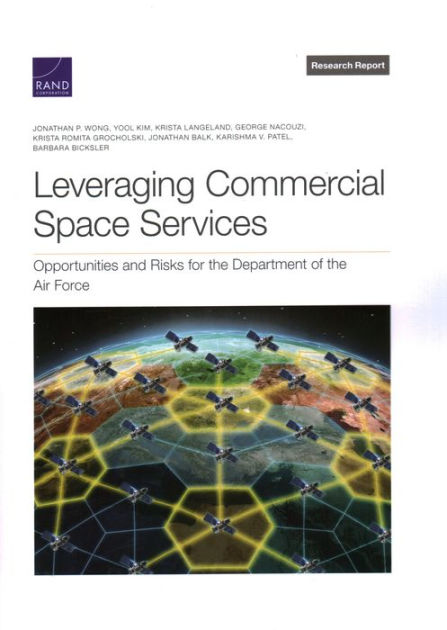Previously (see here and here), I surveyed two new official public policy reports — one by the Department of Defense; the other by the Space Force — calling for U.S. military to procure some of the services and systems they need for their outer space operations from private commercial providers. As it happens, the RAND Corporation has also published a detailed report (the cover of which is pictured below) describing the risks and benefits of the U.S. military’s “partnership activities” with the commercial space industry. (As I mentioned in a previous post, this third report, which is dated 6 September 2023, is titled “Leveraging Commercial Space Services: Opportunities and Risks for the Department of the Air Force” and is available here.)
Alas, like the DoD’s April 2 report and the Space Force’s April 8 report, the 2023 RAND report does not discuss the elephant in the outer space room: how our growing demand for commercial satellite space services will most likely continue to produce a proliferation of satellite constellations and other spacecraft in an already congested Low Earth Orbit or LEO. Rand’s report merely mentions in passing how the number of commercial satellite communication systems in LEO “is increasing at an astonishing rate” (p. 27). By way of example, “SpaceX is currently providing Ku-band global coverage using nearly 3,000 satellites and has plans to exceed 30,000 satellites over the next few years ….” (Ibid., citing Jeff Foust, “GEO Operators Say They Can Compete Against LEO Systems on Cost,” SpaceNews, March 22, 2022, available here; see also Jamie Morin and Robert S. Wilson, Leveraging Commercial Space for National Security, Center for Space Policy and Strategy, Aerospace Corporation, November 2020, available here.)
In an appendix, the RAND report further describes the increased demand for commercial satellite communication or “SATCOM” services and systems and also identifies several legal challenges confronting the commercial space industry (Appendix C, p. 52, emphasis added):
Today’s demand landscape is different [from that of the the 1990s when high costs and limited demand kept the LEO market small], as the state of technology has generally advanced and demand for bandwidth has soared across every sector. This increased demand generally creates an opportunity for growth in the SATCOM market, and the need for more internet communications is well beyond current supply. But growth in demand is not sufficient to ensure a firm’s viability. In the process of pursuing a place in the pLEO [proliferated Low Earth Orbit] market, firms need to secure spectrum access, orbital deployment authority, and the authority to operate while in space and then ensure financial sustainability thereafter ….
The appendix then points out “two major regulatory factors” in the proliferated Low Earth Orbit market (pp. 52-23, footnotes omitted, emphasis added):
The first, securing access to the spectrum and orbital resources, is considered by many to be the biggest challenge to pursuing pLEO. Spectra and orbits are finite, so once a regulatory agency—such as the FCC, the International Telecommunication Union, or an FCC-equivalent agency in another country—allocates those resources, they are locked until the winning firm fails to meet the criteria to operate in the market or reallocates its spectral and orbital rights. For example, in the V-band spectrum, more than 94,000 satellites have been proposed to the FCC in a rush to secure access to the spectrum and orbits.
When incumbent firms with existing licenses or an ability to navigate the regulatory space are favored in the allocation of the spectrum regardless of whether they can deliver services, it is more difficult for new firms to enter the market. To ensure that licenses are used, the FCC does have a caveat in its allocations that a firm must launch at least half of its proposed satellites by the sixth year of a license and all of its proposed satellites by the ninth year. However, the FCC does not necessarily consider the soundness or feasibility of a business plan in its rulemaking. If a firm occupies a part of the spectrum or orbits and fails to deliver, this could lead to an inefficient use of resources. At the same time, a firm’s ability to innovate can be stymied by the potentially time-consuming process of obtaining a license from the FCC
The second regulatory factor … is the impact of the FCC’s and similar regulatory organizations’ decisionmaking timelines on schedules for delivery of services. Furthermore, when the spectrum has been allocated, the decision has not always been final. For example, the FCC reallocated a portion of the C-band spectrum to the 5G industry in 2020. These uncertainties add to the financial risks that firms face as they navigate the process of obtaining access to the spectrum.
The RAND report thus identifies two significant challenges facing the commercial space industry (i.e., the finite nature of low Earth orbits and the lack of stable property rights in those orbits), but it does not propose a solution to either problem. To this end, my colleague Justin Evans and I would like to make a modest proposal: why doesn’t the FCC (or better yet the ITU) start creating well-defined property rights in orbits and allow for those rights to be traded? Building on my previous work, we will further discuss our novel “space auctions” proposal in a future post.




Pingback: Lit review: survey of proposed solutions to the tragedy of the outer space commons | prior probability